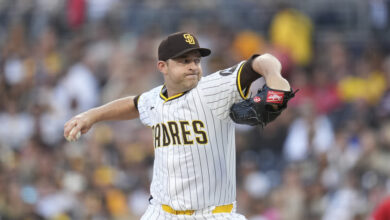
Here’s What Cubs’ Mid-Market Offseason Strategy Might Look Like
Let me go ahead and say right off the jump that I don’t agree with the Cubs acting like their NL Central rivals when it comes to frugality. However, we know what they’ve said about not being profligate with their money and there’s not much use in shaking our fists at clouds and being angry about them not taking a different tack. I mean, feel as angry as you want, it’s just not going to change anything. As such, I wanted to look at the value-based wish list Marquee’s Lance Brozdowski shared earlier in the week.
Among the four players listed are three names we’ve discussed here previously — Nathan Eovaldi, Kyle Finnegan, and Jordan Romano — and another who’ll make his first appearance on CI. That would be Kyle Higashioka, a 34-year-old career backup with the kind of pop that has made him an excellent secondary option behind the plate. None of these players projects to get more than three years and they combine for just $41 million in average annual value.
Come with me as I spend $41m of the #Cubs 2025 payroll in free agency. ? @WatchMarquee pic.twitter.com/ng0jrTts8N
— Lance Brozdowski (@LanceBroz) November 26, 2024
With their payroll currently projected at roughly $54 million below the $241 million luxury tax threshold, the Cubs could fill several needs with room to spare. They may need to create even more room if the reports about them aggressively shopping Cody Bellinger are true, as that could indicate an edict to keep costs well below 2024 levels that saw them exceed the first penalty level with nothing to show for it.
For all the pearl-clutching over their refusal to pursue elite free agents, the Cubs have had success shopping in the middle tier for pitchers. The best example of that is Shōta Imanaga, who just finished fifth in NL Cy Young voting as a rookie, then you’ve got Marcus Stroman and Jameson Taillon. Of course, Imanaga fell into their laps when his market never developed as projected. Then you figure that these guys all have very limited potential to elevate a team into contention.
The same is true of Eovaldi, who just turned down a $20 million option with the Rangers in order to test free agency. He’s entering his age-35 season and his fastball is down a couple ticks from a few years ago with the Red Sox, but sitting around 95 mph would make him the hardest-throwing member of a rotation that has been notoriously weak in terms of velocity. If Brozdowski is close to accurate with that $17 million AAV figure, this would definitely fit Jed Hoyer’s desire for value.
We did a deeper dive into the potential for the Cubs to sign either Romano or Finnegan, both former closers who would solidify the back end of the bullpen at low cost and time commitment. Both righties were non-tendered into their final year of arbitration eligibility and should be motivated to earn bigger deals in free agency next winter. I don’t see the Cubs landing both, especially given Hoyer’s reluctance to pay much for relievers, but we know the front office is aware that it can’t keep cobbling the bullpen together with kite string and duct tape.
Higashioka is an interesting choice here because his addition would significantly narrow the path for Moises Ballesteros to reach the majors. The longtime Yankees backup spent last season in San Diego and clubbed a career-high 17 homers in 263 plate appearances. That’s three more dingers than four Cubs catchers combined to hit over 568 PAs last year and one more than they hit in 720 PAs a year earlier. For a team that needs to add power and may not want to pay for an everyday player to provide it, Higashioka looks like a great fit.
Again, though, that means the only spot for Ballesteros is as a DH and occasional fill-in at first base or catcher. If the Cubs aren’t able to move Bellinger, none of those spots will be available. The need to find room for Mo Baller, Owen Caissie, and other top prospects may be providing as much impetus for a trade as Bellinger’s minimum $32.5 million guarantee.
I’m not trying to convince you to like the potential for the Cubs to follow Brozdowski’s list, but I do think they’d be a better team with these four additions and perhaps one big subtraction. They would be improving a bullpen that cost them several wins early in the season while increasing velocity, swing-and-miss, and power. What’s more, they’d clear space for young players to come up and potentially replace Bellinger’s disappointing production.
Or maybe they do none of that and surprise us by going in a very different direction over the next few weeks.

